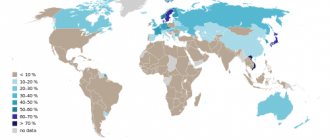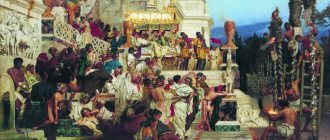The number of Old Believers still living in the taiga along the banks of the Yenisei amounts to thousands. At the same time, we are talking not only about the inhabitants of remote monasteries or monasteries (they began to appear here in the 18th century and still exist), but also about the inhabitants of villages that are quite populous by modern Russian standards. Many of them still live with Soviet passports or without documents at all, including foreigners who once moved to Eastern Siberia. For a long time, both the authorities and the Old Believers themselves were quite happy with their isolated existence - however, they increasingly collide with civilization, and often these collisions turn out to be painful. At the same time, no protection mechanisms are provided for representatives of such communities in the region where they historically live. How life is organized in the taiga today according to the rules of past centuries, how local residents and regional authorities feel about such a neighborhood - in a large material from Izvestia.
From Brazil to Turukhansk
Hanofer Efimov de Queiroz moved from Brazil to Eastern Siberia almost two decades ago with his mother and has since lived in the Turukhansky district. At first, together with his mother (she brought him to Russia as a teenager), he remained in one of the monasteries still located in the taiga, and after her death he moved to the Old Believer village of Chulkovo, located on the banks of the Yenisei, more than 300 km from the regional center, Turukhansk .
Turukhansk
View of Turukhansk from the Yenisei
Photo: TASS/Vladimir Velengurin
In October 2021, most federal and regional media wrote about him: at the end of summer he was stopped on the river by fishery inspectors. Having tried to check the documents of the offender, they discovered that the man actually did not have any - according to Hanofer, his Brazilian passport was burned in a fire several years ago. The only documents left are the birth certificate, and that is in Portuguese.
Old Believers from South America moved to the Amur region for a “hectare”
A new settlement, where 24 Old Believers live, was formed 10 km from the city of Svobodny
Then the situation developed quickly - at the end of September, Hanofer, leaving his wife Antonida (also one of the local Old Believers) and three children in the village, appeared in the court of the Turukhansky district. The judge ordered the deportation of Hanofer, he was taken into custody and transferred to Krasnoyarsk. Human rights activists and journalists stood up for him, Hanofer’s supporters called on the authorities not to separate the family, especially since they had been happily working “on the ground” until now. The arguments, and the persistence of the defenders, worked. In early October, the Krasnoyarsk court overturned the deportation decision, the regional Ministry of Internal Affairs promised to support him, and in a public page dedicated to the work of regional police officers, they even posted photographs of a happy Hanofer with his wife and a new marriage certificate.
After this, human rights activists took Hanofer to Moscow, where he contacted the Brazilian Embassy in Russia with a request to restore his passport. He has not yet received the document, but he, as the spouse of a citizen of the Russian Federation, no longer faces deportation, human rights activist Olga Suvorova, who helps the Old Believer’s family, explained to Izvestia.
Old Believers
Hanofer Efimov di Queiroz, an Old Believer from the Turukhansky region, legalized his marriage with his common-law wife
Photo: vk.com/Krasnoyarsk Police
However, most likely, Hanofer’s story is just the tip of the iceberg. There may be hundreds, if not thousands, of people with expired or missing documents on the Yenisei. Many of them are most likely citizens of other states - and when confronted with official bodies that, apparently, are not very prepared for their appearance, they will receive an equally harsh reception.
Old Believers received almost 6 million rubles for dairy farming
Parishes of the Russian Orthodox Church
According to the report of the chairman of the Pomeranian community, Alexei Alexandrovich Bezgodov, at the 2021 conference “Old Believers, State and Society in the Modern World,” the Russian Orthodox Church was established on the lands of the Austrian Empire in the settlement of Belaya Krinitsa in the middle of the 19th century, when the “Beglopopovtsy” received Metropolitan Ambrose from Sarajevo .
In the 21st century, this agreement is headed by Metropolitan Kornili Titov. Consent in Russia has 184 parishes, 12 dioceses, 7 bishops and 1 active convent near Uglich - Nikolo-Uleymensky.
According to some reports, members of this church in Russia are 500 thousand Russians who live in the Volga region, Central Russia, the Urals, the Russian North and Siberia. The largest number of parishes are located near Nizhny Novgorod and in the Vladimir region - 15 parishes; in the Novosibirsk, Omsk, Tyumen regions, Altai Territory and the Altai Republic - more than 15 parishes. 12 parishes of the church are located near Yaroslavl and Kostroma, in the Vologda region and near Murmansk, in Komi, as well as near Ivanovo and Arkhangelsk. But most of all - 24 parishes are located in the Urals: near Perm, Orenburg, Yekaterinburg, Kurgan, Chelyabinsk and in Bashkiria.
“Only the initiated know what’s going on there”
The Dubches River, a northern tributary of the Yenisei River, is considered the world “capital” of the Old Believers - at least for the Old Believers of the Chapel Concord. This is one of the trends that grew out of the movement of non-priests - that is, those who reject the need for clergy in principle.
People began to settle here at the end of the 17th century - shortly after the schism of 1650-1661, which was followed by persecution of those who chose to adhere to the old faith. Many went to Siberia voluntarily, hoping to find the salvation of their souls; many were simply exiled to the deep Siberian forests.
Today, in the taiga, along the banks of the great river, there are still closed monasteries and monasteries, which cannot be entered by a “worldly” person. “One day, correspondents flew there by helicopter, and the inhabitants of the monastery simply went into the forest,” one of the residents of the Turukhansky district told an Izvestia journalist.
Old Believers
Photo: RIA Novosti/Valery Melnikov
Here, on Dubches, is the village of Sandakches - in fact, the center of the local Old Believers, through which most people who come as pilgrims or with the desire to move to these areas pass.
Author of the quote
- There on Dubches. — Approx. ed.> - absolutely closed territorial entities, only initiates know what is happening there, no one from the world has been there and will not be there - they are not allowed there. All that is known about them is that people pray there, do not eat meat, live by traditional crafts, but do not hunt, live only by fishing - there are not even guns in the monasteries, says Olga Suvorova.
Stay human: citizens of the Russian Federation were considered dead
A cult-like movement of “the living” is spreading in Russia, paralyzing the work of government agencies
Many pilgrims come to visit these places, including from Old Believer communities located all over the world: from Canada to Latin America and Africa. Some of them remain in monasteries for years. This is exactly how, the human rights activist explains, people with expired documents and, often, foreign passports appear on the banks of the Yenisei.
Author of the quote
“People come here to keep their faith pure, they think so,” Nikolai Shlyakhov, the head of the Verkhneimbatsky rural settlement, to which the village of Chulkovo belongs, explains to Izvestia. He himself is not an Old Believers, but over decades of neighborhood he has managed to study their way of life quite well. “There are now too many temptations in the world, so many people send their children from Europe or other countries to local monasteries.
Information about closed and remote monasteries from the world is also confirmed by the story of a girl from the USA, which, according to her, spent 15 years in one of these monasteries, was distributed several years ago in many publications.
She told reporters that her Old Believers relatives sent her as a teenager to the monastery on Dubches with an organized pilgrimage group, but after some time the people who came with her simply left - and the girl realized that a “one-way ticket” had been taken for her. The girl managed to escape from the monastery only after 15 years, and, as follows from her story, residents of nearby villages, also Old Believers, helped her get to Yeniseisk.
Old Believers
Photo: RIA Novosti/Ilya Pitalev
Non-religious views
Why shamanism will not become an official religion in Russia
True, Nikolai Shlyakhov, talking about monastic life from the words of familiar Old Believers, says that “no one keeps them there by force” - if a person feels that he cannot cope, that such a life is not for him, he can leave and settle in an ordinary Old Believers village .
Such villages, where mostly families live, as opposed to monasteries, are well known to the locals, and their residents, according to Olga Suvorova, try to interact with the worldly in their own way.
“I always knew that in Dubches we have a community of bespopovtsy, that Chulkovo is an Old Believer settlement, that the captains of passenger ships maintain relations with them, as well as individual citizens who go fishing and hunting,” she explains.
Old Believers, who live by hunting, fishing, and agriculture (in Chulkovo, according to her, residents grow potatoes and feed dairy bulls), trade with the locals. Either by barter, or for money, which they still need to purchase fabrics, clothes, shoes and all kinds of tools.
Author of the quote
The total number of Old Believers in Russia today is estimated at approximately 2 million people; there are two churches in the country - the Russian Orthodox Old Believers Church (ROC) and the Ancient Orthodox Pomeranian Church (DOC). In the north there are mainly DOC communities, many of them are not officially registered (including due to the inaccessibility of the areas in which they are located). In addition, Old Believer communities exist in Eastern Europe, Latin America, Canada and Australia. Many Old Believers moved there at the beginning of the 20th century, as well as in the 1930s, to escape persecution by the Soviet regime.
RDC parishes
The RDC arose in the 1920s of the 20th century and by the 1950s united the Beglopopovites who did not recognize the Belokrinitsky Church. The largest spiritual center of the church is located in the city of Novozybkov near Bryansk. The church is headed by Patriarch Alexander Kalinin.
According to the Ministry of Justice of the Russian Federation, there are 105 parishes of Novozybkovites in the country, united in 6 dioceses, in which 4 bishops serve. The church has 4 monasteries - three for women and one for men, and a religious school in Novozybkov.
The main work takes place in the Nizhny Novgorod region and the Republic of Buryatia. Adherents of the church are concentrated in Moscow and the Moscow region (Moscow diocese), along the Volga River - Upper Volga and Lower Volga dioceses, in the Urals, Siberia and Buryatia. There is no data on the number of parishioners, and on the official page of the church only 40 parishes are indicated, which are located near Perm, Penza, St. Petersburg, near Samara, near Nizhny Novgorod and near Bryansk.
Visa overdue for 10 years
If some people, having left the monasteries, settle on the Yenisei, then some return to their homeland - to Canada, Bolivia, Uruguay, Argentina, North America, Australia or Brazil. Provided, of course, that they have travel documents.
What kind of faith is measured: adherents of non-traditional religions in power in Ukraine
Why neo-pagans and Baptists are becoming an influential force in the country
Olga Suvorova herself says that she can name about 20 people who in recent years have encountered a situation similar to Hanofer’s, and also mentions an Old Believer whose documents were in order, but required “advisory support”: a person he just didn’t know where he needed to go with them.
Until now, however, she had no contacts with local Old Believers, but she communicated with representatives of the Old Believers community from Brazil. This is what may have helped save Hanofer from deportation.
Author of the quote
— Five years ago I was returning with a group of tourists from the north on one of the ships along the Yenisei. — Approx. ed.>. And so an Old Believer sat in Chulkovo, who had a Brazilian passport and a visa that had expired for 10 years. And the river police immediately reported the illegal immigrant to the shore. The migration service came to meet him in Yeniseisk, and I realized that we needed to act very quickly. As a result, with the most prompt intervention we were able to prevent court decisions, imprisonment and deportation, straighten his documents, and he calmly left for Brazil,” says Olga.
This man was Dionysius, an Old Believer, who as a boy remained in one of the Yenisei monasteries, where he met Hanofer. When Hanofer was transported to Krasnoyarsk, he contacted Dionysius, who, in turn, turned to Olga for help. According to Olga, she is not aware of any attempts to intervene in what is happening on the part of Russian Old Believer organizations.
Old Believers
Old Believer Hanofer Efimov de Queiroz with his wife and children
Photo: vk.com/Krasnoyarsk Police
If Hanofer had not had contacts with Dionysius or Dionysius had not known Olga Suvorova, it is unknown how his story would have ended. But the presence of a family (albeit unofficial) also spoke in favor of Hanofer. And if in his place there is a lonely person, it will be very difficult to save him from deportation - even if no one has been waiting for him in his homeland for a long time.
Siberian voyage: a ship-church set off for remote villages
Participants in the unusual mission include priests, doctors and social workers
Abbots
Monastic
- Tarasiy (May 15 - July 1866)
- Onufriy (Parusov) (July 1866 - mid. 1867)
- Pafnuty (Ovchinnikov) (mid. 1867 - June 10, 1868)
- Pavel (Lednev) (June 11, 1868 - April 27, 1895)
- Jerome (May 1895 - mid 1896)
- Sergius (mid. 1896 - 1908)
- Mina (Shustov) (1908 - April 17, 1911)
- Nikanor (Kudryavtsev) (October 1911 - October 30, 1923), bishop. Bogorodsky
Parish
- Nikolai Sinkovsky (? - 1955)
- Vasily Studenov (? - 1973)
- Vadim Grishin (1974 - 1981)
- Leonid Kuzminov (February 6, 1981 - December 29, 2016)
- Alexy Timakov (since January 31, 2017)
| Holy Cross Gate Church of the former Moscow St. Nicholas Monastery of Edinoverie. Photo July 17, 2014 |
Dead village
However, documents are far from the only problem that both the Old Believers themselves and the municipal authorities in the areas in which they live face. The village of Chulkovo, where Hanofer lives, says Olga Suvorova, arose on this site back in the 17th century. Then it fell into disrepair and was considered “dead” until the 1970s.
In the 1970s, it was revived, but not administratively, but spontaneously - two Old Believer families, fleeing persecution from the Soviet regime, simply arrived, built a house and began to live. They were joined by other Old Believers, including those who left the monasteries located on Dubches, returning to worldly life. This, explains Nikolai Shlyakhov, was then convenient for both the Soviet administration and the Old Believers - and for a long time two completely different worlds calmly coexisted side by side.
Now 77 adults and children live in Chulkovo. But when human rights activists took up the case of Hanofer Efimov, it turned out that the settlement had no official status. That is, even if a member of this community wants to get a passport, the FMS will be able to issue him a document, but will not be able to register it - formally their houses do not exist.
Old Believers
Village of Old Believers in the Krasnoyarsk Territory
Photo: TASS/Ivanov Vitaly
In the Verkhneimbatsky village council, which includes the settlement, back in 2014 - that is, long before the high-profile story with Hanofer Efimov - a master development plan was adopted, according to which, among other things, it was supposed to finally assign the official status of the settlement to Chulkovo.
It's time to go home: the number of “new” Russians is approaching a million
Deputy Foreign Minister Grigory Karasin spoke about the growing interest in the state program for the resettlement of compatriots to Russia
With this, representatives of the village council, according to the established procedure, turned to the regional authorities - but, as practice has shown, the procedure turned out to be more complicated than people in a small village located hundreds of kilometers from large cities could have imagined.
Author of the quote
“We have been working for two years now to assign official status to this settlement, but it turned out to be not so easy. Just now I spoke with the legislative assembly of the region, and they told us that they were returning the documents that we had previously sent for revision,” Nikolai Shlyakhov explains over the phone.
At the same time, Olga Suvorova emphasizes, registration of the status of a settlement would also make it possible to replenish the budget of a rural settlement: after all, in this case, its residents will pay taxes, for example, on real estate. “In exchange, for example, for the authorities to help them clear the road with a grader.” When asked if she is sure that the Old Believers are really ready to pay contributions to the treasury, she confidently answers “yes.”
During the Soviet years they tried to exterminate the Old Believer Church, but after the war they left it alone
The Soviet era brought damage to all religions. The Old Believer Church is no exception. The bishops were subjected to repression, but did not disappear completely. The monasteries were abolished. Reprisals were carried out against believers.
In 1988, the Archdiocese of Moscow was transformed into a metropolitanate
Literally only a few remained representatives of the highest clergy and heroically supported the life of the Old Believer Church, risking their own every day.
After World War II, the government was no longer in the mood for reprisals against Old Believers, so they managed to ordain new bishops.
“The fishery was called poaching”
At the same time, since 2006, Russia has had a “State Program to Assist the Voluntary Resettlement of Compatriots Living Abroad to the Russian Federation.” According to it, including Old Believers living abroad, they are actively invited to return to the Far East (another pre-revolutionary center of Old Believers in Russia).
Old Believers
Photo: TASS/Ivanov Vitaly
Those who decide to move are offered assistance, including financial assistance, in registering land ownership and building houses. However, with regard to the Old Believers, who never left Russia, some ambivalence arises here.
Author of the quote
“It turns out that help is promised to those who are just planning to come, but those who live on this land traditionally, as is the case, for example, with the Yenisei Old Believers, cannot count on it: they have neither benefits nor preferences, - says Olga Suvorova.
Hermit Agafya
How the only representative of the famous Lykov family spends the winter in the taiga
This inconsistency also looks strange to representatives of communities from other countries, especially considering that many communities maintain close ties with each other. Including with Russia.
- It all looks like we are inviting the Old Believers with one hand - they say, come to us in the Far East, you will get preferences and documents. On the other hand, we are talking about those who already live on the territory of the Russian Federation: guys, they are not ours at all. Let them first come to you - and painfully, through detentions, trials and bars, and then we will see, maybe then they will be able to return to us and live well and healthy in the Far East, - Olga Suvorova points out.
For example, a serious problem for the Old Believers, who live mainly by hunting and fishing, is the tightening of fishing rules. The Old Believers, although they adhere primarily to their internal rules, also do not want to break the laws common to all. But they will not be able to survive without hunting and fishing.
Old Believers
Photo: RIA Novosti/Boris Babanov
It was during one of these increasingly frequent fishery inspection raids, for example, that Hanofer Efimov was detained on the Yenisei (he did not deny that he was fishing illegally).
Author of the quote
“They live by subsistence farming, from fishing, and fishing is now called poaching. And if now they tighten the screws further, what will they do, where will they get other income?” — the Siberians next to them shrug their shoulders.
Teacher by vocation
How do millennial monks live in Buddhist monasteries in Mongolia?
Olga Suvorova agrees that Old Believers living a secluded life in the taiga could benefit from quotas similar to those in force for the indigenous peoples of the North - after all, she points out, Old Believers have lived here since the 17th and 18th centuries. Around the same time, Russia learned about the existence of the indigenous peoples of the North. It turns out that they have existed side by side for almost three centuries, both of them live in rather closed communities that preserve the historical way of life. And they are equally dependent on traditional crafts. However, some have, say, fishing and hunting quotas, while others do not.
However, in the case of the Yenisei, such additional privileges may raise questions among residents of neighboring villages, even though the residents generally treat the Old Believers calmly. The issue of tightening fishing rules here is a sore point for everyone (“We have few jobs and a lot of fish, hunters have always fed their dogs with it”).
Old Believers
Photo: RIA Novosti/Alexander Polegenko
According to data reported to Izvestia by Siberian human rights activists, up to 70% of men on the Yenisei, in one way or another, already have a criminal record due to violations of fishing rules. And it is unlikely that people will react with understanding to the fact that the Old Believers will be transferred to a privileged position, emphasizes Nikolai Shlyakhov, a Siberian who calls himself an old-timer of the Turukhansky region.
"Problem" population
The head of the Verkhneimbatsky village council himself clearly treats the Old Believers with respect. But as a “man in power,” he has questions for them—in a conversation, he calls “his” Old Believers a “problem population.”
Author of the quote
— They still live with Soviet passports. And this is a problem for us - we force them, for example, to document their children and change their passports themselves. I was recently in Chulkovo, talked with an Old Believer there, asked to show my passport - and he still had a Soviet one,” says Nikolai Shlyakhov.
Church as a target
Who and why attacked churches and clergy in recent years
Many Old Believers do not seek to draw up or re-register documents because they associate them with evil spirits and prove to local authorities that the documents allegedly contain the “number of the beast.” In response to any attempts to convince them, they simply say: “We won’t receive a passport,” and under any pretext they try to avoid this topic.
Or, they say in the Verkhneimbatsky village council, there is an example of the same Hanofer Efimov.
Several years ago, when he was just getting ready to marry Antonida, he already came to Nikolai Shlyakhov and asked for a Russian passport, explaining that he was born in Krasnoyarsk. The head of the village council did not believe it - and then Hanofer admitted that he was a citizen of Brazil.
Nikolai Shlyakhov recalls that he offered to bring all the available documents in order to somehow resolve the issue of restoring the documents. For example, send a request to the consulate, and warned that the procedure will most likely be long and complicated. “He left and never appeared again,” laments the municipal head.
river
View of the Yenisei
Photo: Global Look Press/Michael Vershinin
It’s even more difficult with paperwork for children. Local residents, who live according to their own internal laws, also do not strive to “straighten” them. To the best of their ability, municipal authorities themselves try to track the birth of newborns in order to convince parents to complete the documents. But among the children who received birth certificates, many never received a passport after reaching 20 years of age: “We are also dealing with these issues,” says Nikolai Shlyakhov.
When building interaction between representatives of such settlements and the “worldly” - including representatives of various government bodies and departments - it is extremely important to avoid conflicts, believes the chairman of the legal center at the Russian Association of Centers for the Study of Religion and Sects, Alexander Korelov.
Russians demonstrated religious tolerance
A Gallup International study found that residents of countries not involved in conflicts are the most tolerant.
Author of the quote
“This is not some kind of destructive sect, these are completely normal people who live in their own closed world. Here it is necessary for local authorities to show some participation and patiently and systematically engage in this work,” the expert notes.









